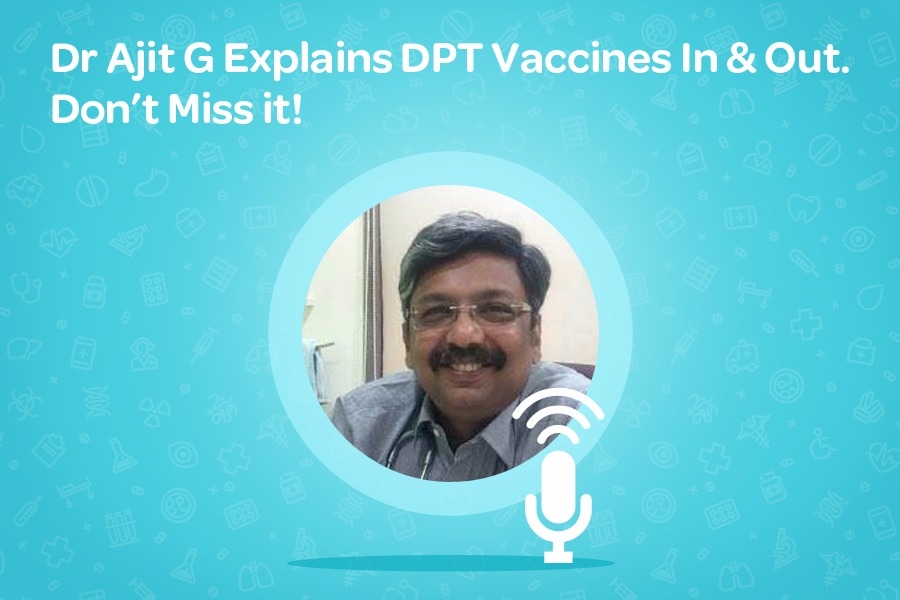
DPT Vaccines Simplified
11 Sep 2017 | 5 min Read
Babychakra
Author | 1369 Articles
So much has been talked of on the internet about DPT vaccines, their effectiveness and the ones that pain less. Let’s take a step back and understand the basics first! After all, it is your newborn’s health in question!
We had a chat with a leading Mumbai-based pediatrician, Dr. Ajit Gajendragadkar to help understand these vaccines.
Why is vaccination important for children?
Vaccinating against diseases is important for children because it helps them fight infections which can be lethal or can leave them with residual handicaps. The whole immunization process was conceived to save the human race from diseases that had caused several deaths in children, particularly below the age of two years. For example – vaccines against diphtheria, whooping cough (pertussis), tetanus, polio, measles are the ones that were the first to be introduced universally. Due to sustained efforts taken towards increasing vaccination coverage, it was possible to reduce mortality rates for most of these diseases. As medical technology evolved, newer vaccines were developed to protect against more diseases.

What are DPT vaccines and at what age are they given?
DPT vaccines offer protection against three diseases. It’s a vaccine against diphtheria, whooping cough (pertussis) and tetanus. These three diseases have historically proven to be threats to newborn babies and infants, so it is given as early as possible. The onus of primary immunization is to cover children under 2 years, which is the most vulnerable age group. DPT vaccines are usually started at 6 weeks at the earliest and different countries have different schedules. In India, we give it monthly – at one-and-a-half months (6 weeks), two-and-a-half months (10 weeks) and three-and-a-half months (14 weeks) with a booster at say, 18 months and a second booster at 4 to 6 years.

What are the different types of combination DPT vaccines and how are they different from each other?
Over time, vaccines against Hepatitis B(Hep B), Haemophilus Influenzae Type B (Hib) and the Inactivated Polio Vaccine (IPV) have been introduced in the immunization programme; some in combination with DPT or as standalone vaccines. So, there are various combinations available now.
You have combinations containing DPT +Hep B+ Hib +IPV or some with DPT + Hib+ Hep B or just DPT +Hib. These are four to six diseases covered in one shot as per the vaccine chosen. Among them, there are two types of combination vaccines; either containing whole-cell pertussis (DPTw) or acellular pertussis (DPTa). The latter is not manufactured in India and is imported, while most others are manufactured here.

Why do some DPT vaccines result in less pain / fever / swelling post injection, while some don’t?
In the conventional DPT vaccine, whole of pertussis bacteria is used. It has a very high content of antigens and proteins, thus causing side-effects associated with it, pain and pyrexia. Pain, fever and swelling come generally as a result of the pertussis part of the DPT vaccine.
In the west, they have refined it and made it an acellular pertussis where the cellular components have been removed but the antigens remain. So, the immunity is supposed to be as good without too many side effects. That’s the main difference between the whole-cell pertussis component and an acellular pertussis vaccine.

In our forums, we often come across advice stating that pain is a good indicator that the vaccine is working. Is it true? How should parents choose the right one for their baby?
Contrary to the popular belief, ‘no pain no gain’, vaccines do not work like that. Here, it is just a question of a newer, more developed vaccine that is less painful. This fact does not make it less efficacious. Efficacy wise, both types of DPT vaccines, i.e. whole-cell pertussis (DPTw) and acellular pertussis (DPTa) are almost comparable but the side effects in the latter are far lesser.

Pain caused after vaccination has no relation to the immunity that the vaccine builds against a disease.
How must pain and reactionary symptoms be handled? How long does it take to recover from those symptoms? Are the vaccines effective if the symptoms don’t appear?
Pain, as a result of vaccination, can be treated symptomatically. You can give Paracetamol for pain, or, apply ice if there is a swelling on the injected part and try to minimize excessive handling/massage for the first day or two. Typically, the side-effects don’t last for more than 24 to 48 hours but in extreme cases, they can last longer. Ask your pediatrician for help if the symptoms get worse.
Side-effects in a vaccine occur because of the nature of some components present in the vaccine, but the severity really depends on tolerance levels and the host response. Mostly, the side-effects aren’t too severe.

Disclaimer: This article is part of Sanofi Pasteur’s educational initiative on vaccines. The views expressed in the article are solely those of the doctor.
Also read: This Mom’s Vaccine Story Will Make You Rethink About Your Baby’s Vaccines!
Explore the entire collection of articles: Baby Care
A


Suggestions offered by doctors on BabyChakra are of advisory nature i.e., for educational and informational purposes only. Content posted on, created for, or compiled by BabyChakra is not intended or designed to replace your doctor's independent judgment about any symptom, condition, or the appropriateness or risks of a procedure or treatment for a given person.
